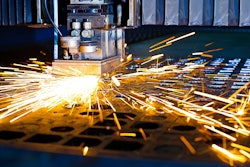Achieving lighting efficiencies in a warehousing and distribution environment has long been a challenge for many companies. Significant strides however, are being made with the introduction of indoor wireless lighting technologies cut energy costs and improve operational management. Antony Corrie, president of worldwide sales at Harvard Technology, a designer, developer and manufacturer of wireless energy saving lighting solutions, explains the benefits the technology brings.
In warehouse environments, where operations typically run on a 24/7 basis, lighting plays a key role in ensuring operations run smoothly and safely. However, when operated inefficiently it can have a huge drain on the financial resources of a business. While it is inevitable that lighting will form a weighty portion of a warehouse’s operating costs — with lighting normally accounting for up to 80 percent of the electricity charges — through effective control and management this expenditure can be kept to a minimum.
As energy costs continue to rise due to global demand, companies are turning to LED lighting technologies to deliver cost savings. However, many are unaware that by combining the technology with wireless lighting control solutions they could accomplish even greater savings.
The value of innovative wireless lighting control solutions can be witnessed by the impressive results achieved at a manufacturing facility. A North American based plastics molding company, whose site comprises manufacturing, warehousing and despatch across two separate buildings, switched to a wireless cloud-based lighting control system and achieved energy savings of $14,960 within just three months.
Deploying lighting control technologies to reduce energy costs, carbon emissions and gain greater multi-site control of their facilities was a major objective for the company. Equally fundamental was optimizing lighting within the two buildings. Reducing and turning off lights in the despatch docking area for loading trailers on days when deliveries were not due.
Several issues had previously impeded the adoption of a wireless lighting control system. A complex layout across the facility and the two buildings containing areas for shipping, docks for loading despatch trailers and large expanses containing plastic injection molding machinery — all separated by thick brick walls — had proved problematic for communicating wireless signals. What’s more security on site did not allow phones, laptops or tablets within the facility, which meant controlling such a wireless solution was a challenge.
The plastics moldings producer understood the importance of specifying a system that was intuitive, flexible and allowed the freedom to completely control the lighting within its two buildings. As a result investment was made to install EyeNut — developed and manufactured by U.K.-based company Harvard Technology — a wireless solution that can not only be used to manage, control and dim lighting, but also provide real time reports on energy consumption.
Prior to installing the new wireless solution, the company’s lighting configuration for the two buildings comprised of 400 metal halide lighting fixtures. The lights operated at 460 watts and could only be switched on and off at a main switchboard, which made lighting costly and extremely difficult to control. The quality of light produced was also poor, with shadows created across the facility, creating difficult and potentially dangerous conditions for workers. While large groupings of fixtures were often left on even when areas of the warehouse were not in use, using unnecessary energy.
A cloud-based, remote access, wireless control, monitoring and management system for indoor lighting, EyeNut gives users the freedom to commission, configure and completely control lighting with multi-site control from a single hub.
Through the solution’s intuitive Graphic User Interface (GUI) usage patterns can be controlled and managed to enable the most effective energy strategy to be implemented, specific to a site’s requirements. Luminaires can be switched or dimmed collectively, or individually, and scheduled to activate lighting when needed. Information on testing for audit tracking and energy hotspots can also be accessed.
The system installed at the Mexico facility comprises a cloud-based EyeNut hub, a single gateway, as well as EyeNut Adapters and 39 occupancy sensors. The solution controls 242 luminaires, with 173 in building one and 69 in building two. All devices are controlled from one wireless gateway, via a robust, secure ZigBee wireless mesh network.
EyeNut was rolled out across the two buildings, together with the new efficient LED fixtures. Since the installation the company has seen an initial energy saving of 70 percent through new fixtures and wireless monitoring alone.
Further mapping of the facility and monitoring of ‘energy hotspots’ has allowed for additional control strategies to be put in place. By grouping luminaires, switches and sensors Harvard Technology has been able to maximize sensors for occupancy detection, meaning lights are dimmed to 30 percent when areas of the facility are not in use. While in zones with natural light the LED fixtures have been dimmed to 50 percent output, leading to substantial energy savings — equivalent to $5,000 per month. Employees are now also benefitting from safer, optimized light quality.
Such was the success of the initial roll-out of EyeNut, the company has achieved energy saving equivalent to $14,960 after just three months, meaning an ROI of just 1 year and 3 months has been delivered.
Antony Corrie is president of worldwide sales at Harvard Technology.






















